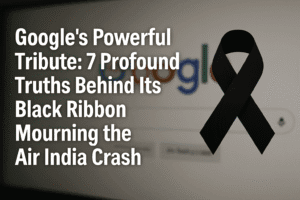Google’s Powerful Tribute: 7 Profound Truths Behind Its Black Ribbon Mourning the Air India Crash
Google’s black ribbon honoring the Air India crash victims transcends a simple gesture. It represents how digital platforms now shape collective grief, transforming a global utility into a space for shared mourning. The tribute’s minimalism forces reflection amid daily routines, while its selectivity reveals tech’s unspoken role in deciding which tragedies resonate worldwide. By focusing on unnamed lives rather than sensational details, it offers dignified remembrance in a click-driven world. This act underscores technology’s evolving responsibility as an accidental historian, preserving memory where physical memorials fade. Ultimately, it bridges digital empathy with the raw human reality on the ground—where true loss and heroism unfold beyond the pixel.

Google’s Powerful Tribute: 7 Profound Truths Behind Its Black Ribbon Mourning the Air India Crash
When Google draped its pristine homepage with a simple black ribbon on June 13, 2025, it did more than memorialize the 241 lives lost in the Air India Ahmedabad crash. It revealed how technology now shapes our collective grieving—and raised profound questions about who gets remembered in our digital public square.
Beyond Sympathy: The Weight of a Single Pixel
Google’s ribbon—hovering silently beneath the search bar—carried no ads, no animations. Its power lay in its austerity. For billions of users worldwide, that minimalist gesture transformed a utilitarian tool into a sacred space. This wasn’t corporate PR; it was a rare acknowledgment that even algorithms must bend to human loss. The message on hover (“In memory of the victims…”) forced a pause in the daily scroll, reminding us that behind every search query lies irreplaceable humanity.
Why This Tragedy? The Unspoken Calculus
Google selectively memorializes events with global resonance or deep societal impact. The Ahmedabad crash—with its multinational victims, mid-air fire witnessed by thousands, and ground casualties at a medical college—transcended geography. The tribute signals how digital platforms now arbitrate which tragedies unite us. It’s a sobering evolution: where once communities grieved locally, today’s mourning is curated by Silicon Valley.
The Survivor’s Paradox in a Headline World
While headlines centered on the lone survivor (the woman “late by 10 minutes”), Google’s ribbon resisted sensationalism. It honored the unnamed 241—the Indian students returning from studies abroad, the Portuguese nurses, the British families. In an era of click-driven trauma porn, this quiet tribute recentered dignity over drama.
Tech’s New Role: Digital Funeral Rites
Physical memorials fade; digital ones persist in search histories. Years from now, someone might find that ribbon’s archive and ask, “What happened on June 12, 2025?” Google has become an accidental historian, preserving collective memory through code. This isn’t just about empathy—it’s about how platforms now steward cultural legacy.
The Ground Truth Beyond the Screen
Amid debates about tech’s influence, we must remember: No pixel can replace presence. As investigators recover the black box and families identify loved ones by dental records, the ribbon’s greatest service may be directing global attention to ground zero—where Ahmedabad’s medical students witnessed hell, and where real heroism unfolded in rescue crews battling flames to save strangers.
You must be logged in to post a comment.